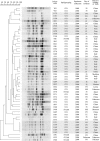Three-year longitudinal study of genotypes of Mycobacterium tuberculosis isolates in Tuscany, Italy
- PMID: 17460055
- PMCID: PMC1933082
- DOI: 10.1128/JCM.00170-07
Three-year longitudinal study of genotypes of Mycobacterium tuberculosis isolates in Tuscany, Italy
Abstract
The genetic diversity of 829 strains of Mycobacterium tuberculosis isolated during a 3-year period in Tuscany, Italy, a country with a low prevalence of tuberculosis, from 480 Italian-born and 349 foreign-born patients was determined by spoligotyping. The predominant spoligotype families were T (30.2% of isolates), Haarlem (19.9%), and the Latino-American and Mediterranean family (LAM) (11.2%); the remaining isolates were distributed among the Beijing (6.5%), S (4.2%), East Africa-India (EAI) (3.0%), Bovis (2.3%), Central Asia (CAS) (2.1%), Africanum (1.3%), and X (1.2%) families or were undefined (2.7%) or orphan (14.1%) isolates. Isolates of the families T, Haarlem, Bovis, and X were distributed among Italian- and foreign-born patients almost proportionally to the patients' numbers. Isolates of the LAM family were prevalent in foreign-born people (13.5%, versus 9.6% in Italian-born patients). Isolates of the S family were found almost exclusively in Italian-born patients, while strains of families EAI and CAS were isolated almost exclusively from foreign-born patients; Africanum isolates were all from African-born patients. The isolates of the Beijing family showed a trend to a steady increase during the survey. The prevalence of Beijing strains was 11.7% among foreign-born people and 2.7% among Italian-born patients. The Beijing strains were typed by the standardized IS6110 restriction fragment length polymorphism assay, which yielded a total of 38 distinct IS6110 patterns; 21 isolates (39.6%) occurred in six distinct clusters; of these, three contained two isolates and the other three contained four, five and six isolates, thus demonstrating that Beijing strains caused several tuberculosis outbreaks in the region. These findings indicate that transmission of Beijing strains between immigrants and the autochthonous population has occurred frequently and suggests an ongoing active transmission of the Beijing genotype in the region.
Figures

Similar articles
-
Genetic diversity, determined on the basis of katG463 and gyrA95 polymorphisms, Spoligotyping, and IS6110 typing, of Mycobacterium tuberculosis complex isolates from Italy.J Clin Microbiol. 2005 Apr;43(4):1617-24. doi: 10.1128/JCM.43.4.1617-1624.2005. J Clin Microbiol. 2005. PMID: 15814975 Free PMC article.
-
Impact of immigration on tuberculosis in a low-incidence area of Italy: a molecular epidemiological approach.Clin Microbiol Infect. 2010 Nov;16(11):1691-7. doi: 10.1111/j.1469-0691.2009.03149.x. Clin Microbiol Infect. 2010. PMID: 20041892
-
First insight into the population structure of Mycobacterium tuberculosis in Saudi Arabia.J Clin Microbiol. 2007 Aug;45(8):2467-73. doi: 10.1128/JCM.02293-06. Epub 2007 May 16. J Clin Microbiol. 2007. PMID: 17507515 Free PMC article.
-
[Findings and ongoing research in the molecular epidemiology of tuberculosis].Kekkaku. 2009 Feb;84(2):83-9. Kekkaku. 2009. PMID: 19280913 Review. Japanese.
-
[Molecular epidemiology of Mycobacterium tuberculosis using by RFLP analysis between genomic DNA--its accomplishment and practice].Kekkaku. 2003 Oct;78(10):641-51. Kekkaku. 2003. PMID: 14621573 Review. Japanese.
Cited by
-
Spoligotype-based comparative population structure analysis of multidrug-resistant and isoniazid-monoresistant Mycobacterium tuberculosis complex clinical isolates in Poland.J Clin Microbiol. 2010 Nov;48(11):3899-909. doi: 10.1128/JCM.00572-10. Epub 2010 Sep 1. J Clin Microbiol. 2010. PMID: 20810763 Free PMC article.
-
Comparison of a semiautomated commercial repetitive-sequence-based PCR method with spoligotyping, 24-locus mycobacterial interspersed repetitive-unit-variable-number tandem-repeat typing, and restriction fragment length polymorphism-based analysis of IS6110 for Mycobacterium tuberculosis typing.J Clin Microbiol. 2014 Nov;52(11):4082-6. doi: 10.1128/JCM.02226-14. Epub 2014 Sep 10. J Clin Microbiol. 2014. PMID: 25210067 Free PMC article.
-
Mycobacterium tuberculosis DNA fingerprint clusters and its relationship with RD(Rio) genotype in Brazil.Tuberculosis (Edinb). 2013 Mar;93(2):207-12. doi: 10.1016/j.tube.2012.09.001. Epub 2012 Dec 8. Tuberculosis (Edinb). 2013. PMID: 23232111 Free PMC article.
-
Prevalence and occurrence rate of Mycobacterium tuberculosis Haarlem family multi-drug resistant in the worldwide population: A systematic review and meta-analysis.J Res Med Sci. 2015 Jan;20(1):78-88. J Res Med Sci. 2015. PMID: 25767526 Free PMC article. Review.
-
Risk factors and clinical phenotypes of Beijing genotype strains in tuberculosis patients in China.BMC Infect Dis. 2012 Dec 17;12:354. doi: 10.1186/1471-2334-12-354. BMC Infect Dis. 2012. PMID: 23245430 Free PMC article.
References
-
- Barnes, P. F., and M. D. Cave. 2003. Molecular epidemiology of tuberculosis. N. Engl. J. Med. 349:1149-1156. - PubMed
-
- Broekmans, J. 2000. Tuberculosis control in low prevalence countries, p. 75-92. In L. Reichman and E. Hershfield (ed.), Tuberculosis: a comprehensive international approach. Dekker, New York, NY.
-
- Brudey, K., J. R. Driscoll, L. Rigouts, W. Prodinger, A. Gori, S. A. M. Al-Hajoj, C. Allix, L. Aristimuño, J. Arora, V. Baumanis, L. Binder, P. Cafrune, A. Cataldi, S. Cheong, R. Diel, C. Ellermeier, J. T. Evans, M. Fauville, S. Ferdinand, D. Garcia de Viedma, C. Garzelli, L. Gazzola, H. M. Gomes, M. C. Guttierez, P. M. Hawkey, P. D. van Helden, G. V. Kadival, B. N. Kreiswirth, K. Kremer, M. Kubin, S. P. Kulkarni, B. Liens, T. Lillebaek, H. M. Ly, C. Martin, C. Martin, I. Mokrousov, O. Narvskaïa, Y. F. Ngeow, L. Naumann, S. Niemann, I. Parwati, M. Z. Rahim, V. Rasolofo-Razanamparany, T. Rasolonavalona, M. L. Rossetti, S. Rüsch-Gerdes, A. Sajduda, S. Samper, P. Seth, I. Shemyakin, U. B. Singh, A. Somoskovi, R. Skuce, D. van Soolingen, E. M. Streicher, P. N. Suffys, E. Tortoli, T. Tracevska, V. Vincent, T. C. Victor, R. Warren, S. F. Yap, K. Zaman, F. Portaels, N. Rastogi, and C. Sola. 2006. Mycobacterium tuberculosis complex genetic diversity: mining the fourth international spoligotyping database (SpolDB4) for classification, population genetics and epidemiology. BMC Microbiol. 6:23-39. - PMC - PubMed
Publication types
MeSH terms
Substances
LinkOut - more resources
Full Text Sources
Medical

